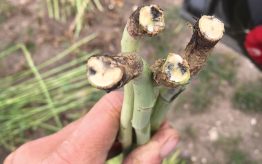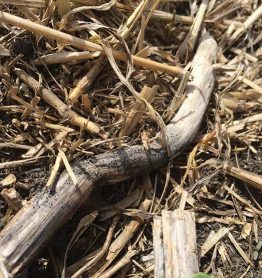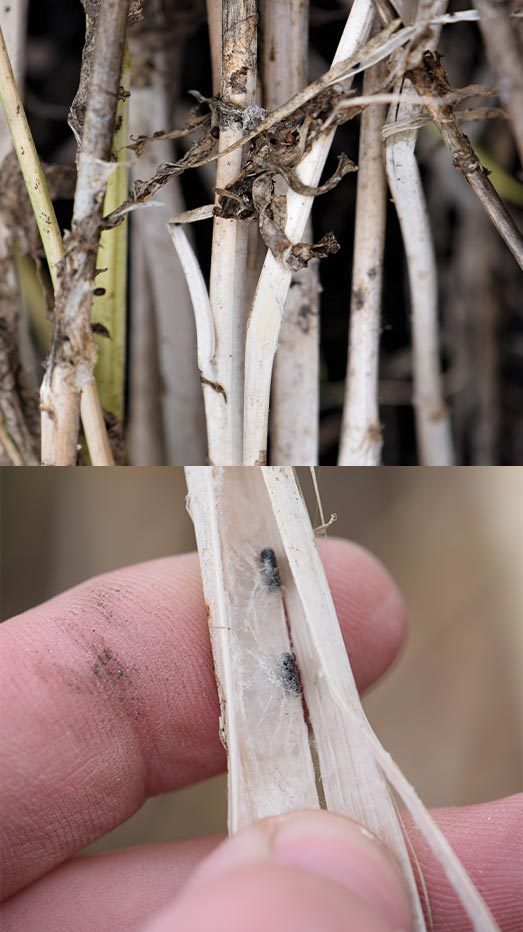New tools to manage blackleg and sclerotinia stem rot
 An Agri-Science Project (ASP) on ‘New tools to help producers manage two serious diseases in canola – blackleg and sclerotinia stem rot’ led by SaskCanola and in partnership with the Alberta Canola and the Federal Government under the Growing Forward 2 Program included 10 research projects and one knowledge and technology transfer (KTT) project to disseminate the findings. Here are result highlights from each project.
An Agri-Science Project (ASP) on ‘New tools to help producers manage two serious diseases in canola – blackleg and sclerotinia stem rot’ led by SaskCanola and in partnership with the Alberta Canola and the Federal Government under the Growing Forward 2 Program included 10 research projects and one knowledge and technology transfer (KTT) project to disseminate the findings. Here are result highlights from each project.

Blackleg
Current projects focused on new sources of resistance are making progress towards providing new resources and information for canola breeding programs to help improve blackleg resistance options for growers.
Improving canola resistance against blackleg disease through incorporation of novel resistance genes sourced from B. napus, B. rapa and B. oleracea
Principal investigator: M. Hossein Borhan, Agriculture and Agri-Food Canada (AAFC) Saskatoon
Findings: An intensive screening of over 1,100 accessions (plant materials collected from a particular area) of B. napus and B. rapa was conducted to search for novel resistance (R) genes against blackleg. Throughout this, a methodology for accurate and rigorous screening of Brassica species for blackleg resistance was created. As well, two B. napus lines with novel R genes were identified and the preliminary mapping conducted on one of these lines supports the presence of a novel broad spectrum R gene.
Identifying novel resistance genes from canola relatives and developing canola germplasm with multiple resistance genes sourced from B. nigra, B. juncea, and B. carinata
Principal investigators: Genyi Li and Dilantha Fernando, University of Manitoba
Findings: The R gene sequences on chromosome N7 were sequenced and functionally confirmed. (They had been studied for three decades but not previously sequenced due to the structural complexity of this chromosome.) Over 10 advanced backcrossing lines (BC5 and BC6) were produced in a susceptible cultivar, Westar, background. All of these lines showed excellent resistance to aggressive isolates of the blackleg pathogen.
Genome-wide association mapping of quantitative resistance against blackleg disease
Principal investigator: M. Hossein Borhan, AAFC Saskatoon
Findings: A collection of 58 spring-type B. napus with adult plant resistance (also referred to as quantitative resistance, a durable form of resistance) against blackleg disease was identified. These lines offer a source of resistance against blackleg for potential incorporation into commercial canola cultivars.
Transcriptomic analysis of the Leptosphaeria maculans (blackleg) and canola interaction to identify resistance genes in canola and avirulence factors in L. maculans
Principal investigator: Richard Bélanger, Laval University
Findings: Three studies in the project produced three key findings:
- A unique pipeline with an exhaustive list of classically secreted proteins (that may stimulate plant infection) along with their key conserved motifs found in 12 common plant pathogens including L. maculans (the pathogen which causes blackleg in western Canada) were provided and will help with future analyses of pathogenesis processes in canola-L. maculans interaction.
- Comparison of the transcriptome of L. maculans during compatible and incompatible interactions has led to the identification of key pathogenicity genes that regulate the fate of the interaction and lifestyle transitions of the fungus.
- A successful in-depth characterization of Brassicaceae aquaporins highlighted transport mechanisms and related physiological processes that could be exploited in breeding of stress-tolerant cultivars.
Durable blackleg resistance stewardship through knowledge of blackleg pathogen population, resistance genes and crop sequence towards the development of a cultivar rotation program in the Prairie Provinces
Principal investigators: Dilantha Fernando, University of Manitoba; Gary Peng, AAFC Saskatoon; Ralph Lange, Innotech
Findings: Understanding the R-gene and the pathogen profiles in the Prairies (by testing L. maculans isolates for the presence of 11 Avr alleles using a set of differentials combined with PCR amplification) has helped the industry to launch the R-gene labeling system and rotation strategy.

Investigating the resistance (R-gene) durability of canola cultivars and the emergence of virulent blackleg isolates in farmers’ fields
Principal investigator: Dilantha Fernando, University of Manitoba
Findings: Field trials reported if and when virulent isolates emerged, the number of generations required to produce virulent offspring, and the comparison results between R gene lines, which increased the understanding of the durability (to disease pressure) of some R genes used within commercial cultivars. This helped form the foundation for current major gene resistance labels.
For more on genetic resistance for blackleg and the new R-gene labels for canola seed varieties, read the ‘Genetic resistance’ section at blackleg.ca.
Rapid field diagnostics of the blackleg pathogen races through the identification of pathogen avirulence (Avr) genes and the development of Avr-specific markers
Principal investigator: M. Hossein Borhan, AAFC Saskatoon
Findings: Through many steps, including cloning genes, generating crosses between isolates and specific gene identifications, polymerase chain reaction (PCR) biomarkers were developed and shared with public and private pathology labs to allow for a rapid ‘in-field’ test to identify blackleg races present on the canola stubble. This helps growers make informed variety selection decisions based on the blackleg strain found in their fields. It also addresses a concern of a major trading partner.
Development of a blackleg yield-loss model and assessment of fungicide resistance in Western Canadian populations of Leptosphaeria maculans
Principal investigator: Stephen Strelkov, University of Alberta
Findings: By studying relationships between blackleg disease severity and yield loss and the fungicide sensitivity of Leptosphaeria maculans populations from Western Canada, this project was able to develop the first yield loss model for blackleg of canola for Western Canada. This model can provide a foundation for understanding the yield impact associated with certain levels of blackleg, not only on a field scale, but also on local or even regional scales.
Integration of canola disease research results within the canola industry.
Principal investigator: Errin Willenborg, Saskatchewan Canola Development Commission (SaskCanola)
Findings: SaskCanola worked alongside AAFC researchers, AAFC commercialization officers and Canola Council of Canada to make the rapid field diagnostics test for blackleg available at commercial labs. This collaboration also led to the development of one 10-minute and three shorter videos, available at spotblackleg.ca, that highlight results from these blackleg projects and a guide on blackleg best management practices, including the new blackleg R-gene labeling strategy.
 Social media was used to draw attention to the video through a ‘Spot Blackleg’ campaign. A workshop shared the results of this ASP, encouraged information exchanges with industry and allowed for the investigation of potential collaboration opportunities around improving the understanding of blackleg in Canada and Australia (where they have an advanced blackleg management system).
Social media was used to draw attention to the video through a ‘Spot Blackleg’ campaign. A workshop shared the results of this ASP, encouraged information exchanges with industry and allowed for the investigation of potential collaboration opportunities around improving the understanding of blackleg in Canada and Australia (where they have an advanced blackleg management system).
Sclerotinia stem rot

Characterization of defense genes underlying quantitative resistance loci (QRL) to sclerotinia stem rot in Asian Brassica napus and transfer of resistance to Canadian spring-type canola
Principal investigator: Lone Buchwaldt, AAFC Saskatoon
Findings: This study generated new knowledge on individual defense genes against S. sclerotiorum and on SNP and SSR markers that can be used in marker-assisted selection. A ‘stem test’ to screen B. napus plants for sclerotinia resistance was also developed and accepted by the canola industry, including adoption by the Western Canadian Canola/ Rapeseed Recommending Committee (WCC/RRC). Work was started on transferring sclerotinia resistance into an elite AAFC line, and new funding will be sought to continue the project in collaboration with breeding companies.
Resistance to Sclerotinia sclerotiorum necrosis inducing proteins in canola
Principal investigator: Dwayne Hegedus, AAFC Saskatoon
Findings: This research contributed to an international consortium that sequenced the S. sclerotiorum genome, which is now serving as a reference for a new international initiative to sequence the genomes a global collection of S. sclerotiorum isolates from a multitude of crops. The researchers catalogued the entire suite of genes expressed during each stage of the infection of canola that has led to a much better understanding of how S. sclerotiorum causes disease. They also identified several new proteins that are secreted by S. sclerotiorum that cause necrosis and began developing tools that will use necrosis proteins to screen B. napus collections for lines that are more tolerant of or resistant to their effects.
For project summaries, look for an update on SaskCanola’s research
page (saskcanola.com/research/projectreports.php) and for final project reports, see the Canola Research Hub (canolaresearch.ca). Find more information on blackleg at blackleg.ca and learn more about sclerotinia in the CCC’s Canola Encyclopedia.





